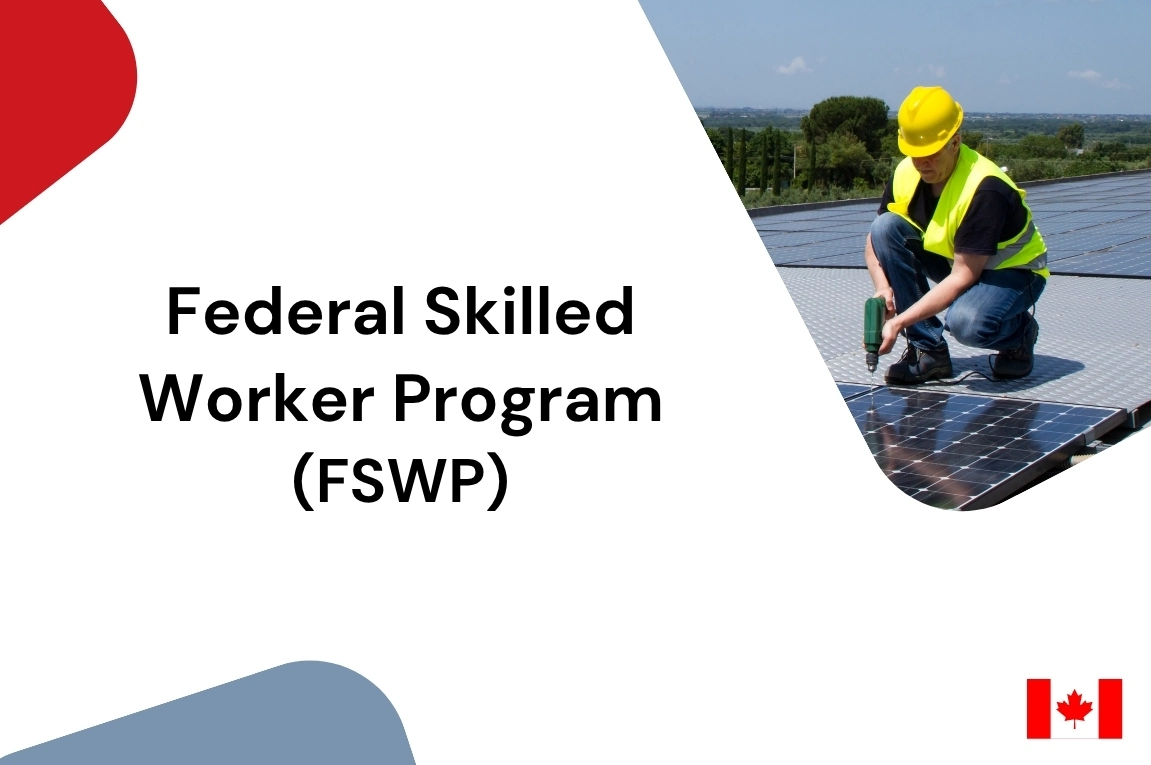Canada Skilled Worker Program: Your Fast and Friendly Pathway to Immigrate Through Skilled Work
Thinking about moving to Canada? You’re not alone! The Canada Skilled Worker Program is one of the most popular and straightforward ways for skilled professionals like you to start a new life in Canada. It’s part of the Express Entry system a quick, points-based immigration process that helps people with the right skills settle in Canada faster.
Why should you consider the Skilled Worker visa? If you qualify, you could get your permanent residency in about six months. And after a few years, if you meet certain requirements, you might even become a Canadian citizen. That’s a life-changing opportunity, isn’t it?
This content is updated for 2025 and has been carefully reviewed by immigration consultants at Sugimoto Visa to ensure accuracy and clarity.
What Exactly Is the Federal Skilled Worker (FSW) Program?
Let’s break it down. The FSW is designed for professionals, educated individuals, and skilled technical workers who want to immigrate to Canada.
In the past, the selection process was less clear, sometimes depending on an officer’s judgment. Now, it’s much fairer! The program is part of the Express Entry system, which scores candidates based on clear factors like:
- age
- English or French language ability
- Education level
- work experience
- type of skills you have
These factors help Canada find the best fit for their labor market needs, and your skills are the key to opening that door.
Pathways to Move to Canada Through the FSW
Canada offers two main routes for skilled workers like you:

1. Express Entry Program
This is an online system designed to find and invite skilled workers who meet the criteria quickly. It rewards you with points based on your age, education, language skills, work experience, and even if you have a job offer.

2. Provincial Nominee Program (PNP)
This option lets you apply directly to a specific Canadian province, depending on its unique labor market needs. Provinces nominate skilled workers to apply for permanent residency. Sometimes, PNP works alongside Express Entry to speed things up.
✅ Not sure which path fits you best? That’s okay, your ideal route depends on your background, goals, and timeline, and we can help you navigate it.
👥 Maria’s Story
Take Maria, a graphic designer from Brazil. She applied through the FSWP, scored well thanks to her strong English and solid work history, and moved to Toronto with her husband and daughter in under seven months. Her story isn’t unique, and yours could be next.
Why Choose the Canada Skilled Worker Program?
Here are some reasons you’ll love this program:
- Fast processing: Most applications are completed within 6 to 9 months.
- Flexibility: You’re free to live and work anywhere in Canada.
- No Canadian experience required: You don’t need to have studied or worked in Canada before applying.
- Fully digital: The entire process is online—no paperwork hassle.
- Lower costs: Compared to investor or business immigration, this route is more affordable.
- Family-friendly: You can include your spouse and dependent children in your application.
Eligibility Criteria
To qualify for the Federal Skilled Worker Program, make sure you meet these criteria:
- At least one year of full-time skilled work experience in a TEER 0, 1, 2, or 3 occupation (this includes roles like managers, engineers, chefs, and truck drivers).
- Language skills at CLB 7 or higher in English or French. (CLB stands for Canadian Language Benchmark, a way to measure proficiency.)
- Minimum of a high school diploma.
- Enough financial resources to support yourself (and your family) upon arrival.
- A score of at least 67 out of 100 on the FSW points grid.
📢 Update July 2025: New Money Rules for Express Entry (FSW & FST)
Canada has just changed the minimum money you need to show for Express Entry. This is important if you’re applying under the Federal Skilled Worker Program (FSWP) or Federal Skilled Trades Program (FSTP).
The new rules started on July 7, 2025. The amount is now a bit higher than before. For example, if you’re single, you now need to show $15,263 CAD in your bank account. Before, it was $14,690 CAD.
If your profile is already in the Express Entry pool, don’t worry—but do update your numbers. Make sure to do this by July 28, 2025, to stay eligible.
| Family Size | New Amount | Old Amount |
|---|---|---|
| 1 person | $15,263 | $14,690 |
| 2 people | $19,001 | $18,288 |
| 3 people | $23,360 | $22,483 |
| 4 people | $28,362 | $27,297 |
| 5 people | $32,168 | $30,690 |
| 6 people | $36,280 | $34,917 |
| 7 people | $40,392 | $38,875 |
| Extra person | $4,112 | $3,958 |
What Jobs Qualify for the Skilled Worker Program?
Here’s a quick look at the kinds of jobs that count:
- TEER 0: Managerial positions (like business managers)
- TEER 1: Professional jobs (think doctors, engineers)
- TEER 2: Skilled trades (electricians, chefs, and more)
- TEER 3: Jobs requiring specific training but less formal education (such as truck drivers, butchers)
If your job fits in one of these categories, you’re on the right track.
How Does the Points System Work?
To enter the Express Entry system under the Federal Skilled Worker category, applicants must score at least 67 points out of 100 based on various factors. These points are calculated as follows:
Minimum Score: 67 of 100
🔸 1. Language Skills (Maximum 28 points)
- Applicants must have at least a CLB 7 level in English or French.
- Accepted language tests include CELPIP and IELTS for English, and TEF Canada or TCF Canada for French. Scores are converted to CLB levels.
- Points are awarded separately for each language skill: Speaking, Listening, Reading, and Writing.
Bonus: If you speak both English and French, you can earn up to 4 extra points with a second language at CLB 5.
| Language Level | Speaking | Listening | Reading | Writing | Total Points (Max) |
|---|---|---|---|---|---|
| CLB 9 or above | 6 | 6 | 6 | 6 | 24 |
| CLB 8 | 5 | 5 | 5 | 5 | 20 |
| CLB 7 | 4 | 4 | 4 | 4 | 16 |
| Below CLB 7 | Not eligible to apply |
🔸 2. Education (Maximum 25 points)
Education points depend on the highest level of completed education. Foreign degrees must be credential assessed for Canadian equivalency.
| Education Level | Points |
|---|---|
| High School Diploma | 5 |
| 1-year post-secondary program | 15 |
| 2-year post-secondary diploma or diploma | 19 |
| Bachelor's degree (3 years or more) | 21 |
| Two Bachelor's degrees | 22 |
| Master's degree or professional doctorate | 23 |
| Doctorate (PhD) | 25 |
🔸 3. Work Experience (Maximum 15 points)
Applicants must have at least 1 year of full-time (or equivalent part-time) paid work experience in NOC TEER 0, 1, 2, or 3 occupations.
| Years of Work Experience | Points |
|---|---|
| 1 year | 9 |
| 2-3 years | 11 |
| 4-5 years | 13 |
| 6 years or more | 15 |
🔸 4. Age (Maximum 12 points)
Points vary by age. No points are awarded for applicants under 18 or over 46.
| Age | Points |
|---|---|
| 18-35 | 12 |
| 36 | 11 |
| 37 | 10 |
| 38 | 9 |
| 39 | 8 |
| 40 | 7 |
| 41 | 6 |
| 42 | 5 |
| 43 | 4 |
| 44 | 3 |
| 45 | 2 |
| 46 | 1 |
| 47+ | 0 |
🔸 5. Job Offer (Maximum 10 points)
Having a valid full-time, non-seasonal job offer for at least 1 year in a TEER 0, 1, 2, or 3 occupation earns 10 points.
Employers often need to provide a Labour Market Impact Assessment (LMIA).
🔸 6. Adaptability (Maximum 10 points)
Points can be earned based on the applicant’s or their spouse’s ties to Canada.
| Adaptability Factor | Points |
|---|---|
| Spouse’s language level CLB 4 or higher | 5 |
| Canadian education (at least 2 years) | 5 |
| Spouse’s Canadian education (at least 2 years) | 5 |
| Canadian work experience (at least 1 year in eligible job) | 10 |
| Spouse’s Canadian work experience (at least 1 year) | 5 |
| Job offer in Canada | 5 |
| Close family in Canada (parents, siblings, aunts/uncles, children, grandchildren) | 5 |
Try [the Canada Skilled Worker Score Calculator] to get a clearer idea of your score.
FSWP Document Checklist
1️⃣ Before Submitting Your Express Entry Profile
You must have these ready:
- Passport or travel document
- Valid and complete, with all personal data and visa/stamp pages
- Language test results
- IELTS General Training or CELPIP General (English)
- TEF Canada or TCF Canada (French)
- Must be less than two years old
- Educational Credential Assessment (ECA)
- Required if you studied outside Canada.
- Accepted assessing bodies: WES, IQAS, ICES, CES, ICAS, MCC (for doctors), or PEBC (for pharmacists)
- Work experience documents
- Reference letters from each employer, including job title, duties, salary, hours, and dates
- Must match your NOC description
- Proof of funds
- Official bank letter showing sufficient funds for your family size (unless exempt because of a valid job offer or Canadian work authorization)
- Digital photo
- Passport-style, 35×45 mm, neutral expression, plain background
2️⃣ After Receiving an ITA (Invitation to Apply)
You’ll have 60 days to submit your full e-APR application.
- Identity and Civil Status
- Valid passport (all pages with stamps or visas)
- Birth certificates for you and dependents
- Marriage certificate, divorce decree, or death certificate (if applicable)
- Adoption papers (if applicable)
- National ID card (recommended)
- Original language test results (IELTS, CELPIP, TEF, or TCF)
- Education Documents
- Educational Credential Assessment (ECA) report (less than 5 years old)
- Diplomas, degrees, and transcripts
- Certified English or French translations if originals are in another language
- Work Experience Documents
- Reference letters for every claimed job under your NOC.
- Must include: Job title, Duties and responsibilities, Start and end dates, Salary and benefits, Full-time or part-time hours, Employer’s contact information
- Pay slips, tax returns, or employment contracts (recommended for proof)
- Proof of Funds
- Police Certificates
- Medical Examination
- Digital Photos (420×540 pixels minimum)
- Proof of Relationship (if applicable)
- Marriage certificate or common-law declaration form (IMM 5409)
- Evidence of shared residence, bank accounts, or utility bills for common-law partners.
- Children’s birth certificates showing both parents’ names
- Proof of family member in Canada (citizenship or PR card + relationship documents) if claiming adaptability points
- Job Offer or Provincial Nomination (if applicable)
- Additional Supporting Documents
- Letter of Explanation (LoE) for missing or unusual information
- All auto-generated IRCC forms are completed online
- Travel history covering the last 10 years (or since age 18)
3️⃣ Submission and Aftermath
- Upload all files as PDFs under 4 MB each.
- Keep originals handy in case IRCC requests them.
- After submission, expect:
- Acknowledgement of Receipt (AOR).
- Biometrics request.
- Possible follow-up for additional documents or updated medical records.
How to Apply for the FSWP (Step-by-Step)
Step 1: Calculate your eligibility score
Make sure you score at least 67 points.
Step 2: Create your Express Entry profile
You’ll share your language test results, education assessments, work history, and proof of funds online.
Step 3: Receive your Comprehensive Ranking System (CRS) score
This is a more detailed score out of 1200. If it’s high enough, you’ll get an Invitation to Apply (ITA) for permanent residency.
Step 4: Submit your documents after getting an ITA
You have 60 days to upload documents like passports, test results, proof of finances, police certificates, and medical exams.
Step 5: Wait for the eligibility review
An immigration officer will review your application, which may take up to 5 months. Sometimes they ask for more info.
Step 6: Get your Confirmation of Permanent Residence (COPR)
Once approved, you’ll send your passport for visa stamping and prepare for your arrival in Canada.
Processing Time and Fess
As of early 2025, expect about 6 months on average to process your application, slightly longer than before but still quite efficient.
This route is budget-friendly compared to many other immigration programs. Here’s a quick cost breakdown:
- Application fee (adults): 550$ CAD
- Application fee (children): 150$ CAD
- Permanent residence fee: 490$ CAD
- Biometrics: 85$ CAD per person
You’ll also pay smaller fees for biometrics (fingerprints and photos).
Skilled Workers That Canada Needs
In recent years, Canada has increasingly shaped its immigration policies around the country’s labor market needs. The focus is mainly on sectors facing a shortage of skilled workers and on occupations that are essential for future economic growth.
By late 2025, the most in-demand professions are concentrated in three main areas directly linked to the Express Entry system:
1. Healthcare and Social Services
Because of severe labor shortages and an aging population, this sector remains Canada’s top priority. It is a key focus in category-based Express Entry draws.
- Registered Nurses (NOC 31301 – TEER 1)
- Licensed Practical Nurses (NOC 32101 – TEER 2)
- Nurse Aides and Orderlies (NOC 33102 – TEER 3)
- General Practitioners and Family Physicians (NOC 31102 – TEER 1)
- Medical Laboratory Technologists (NOC 32120 – TEER 2)
- Social Workers (NOC 41300 – TEER 1)
2. STEM and Technology
(Science, Technology, Engineering, and Math)
- Software Engineers and Developers (NOC 21231, 21232 – TEER 1)
- Cybersecurity Specialists (NOC 21220 – TEER 1)
- Data Scientists and Analysts (NOC 21211 – TEER 1)
- Civil, Electrical, and Mechanical Engineers (NOC 21300, 21310, 21301 – TEER 1)
- Architecture and Science Managers (NOC 20011 – TEER 0)
3. Trades and Construction
Due to the urgent demand for housing and infrastructure development, trades and construction occupations have become a major priority for immigration.
- Carpenters (NOC 72310 – TEER 2)
- Electricians (NOC 72200, 72201 – TEER 2)
- Plumbers (NOC 72300 – TEER 2)
- Welders (NOC 72106 – TEER 2)
Final Thoughts: Is the FSWP Right for You?
If you’re a skilled professional or technical worker looking for a fair, transparent, and cost-effective way to move to Canada, the Federal Skilled Worker Program might just be your best opportunity.
You don’t need a job offer to apply, and you can bring your spouse and children (under 22) with you. Plus, you can settle anywhere in Canada that suits your lifestyle.
Sounds exciting, doesn’t it? If you want to learn more or need guidance, why not start by checking your eligibility? We’re here to help you every step of the way.
FAQs
Your profile stays active for one year. After that, you’ll need to create a new profile if you haven’t been invited yet.
Yes! You can bring your spouse and children under 22.
Younger applicants score higher, but even if you’re older, other strong qualifications can boost your chances.


